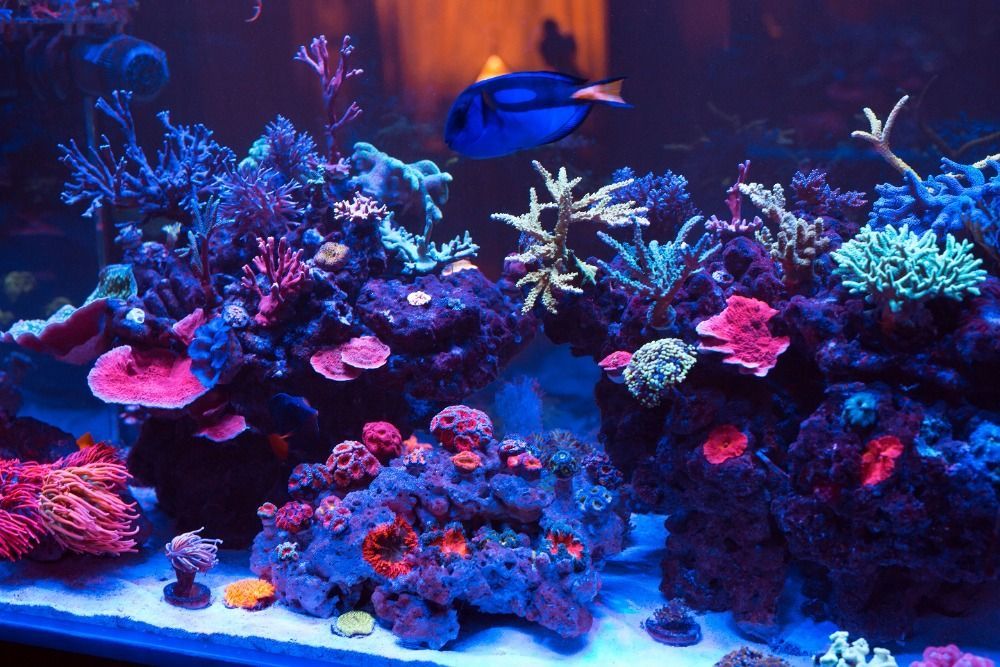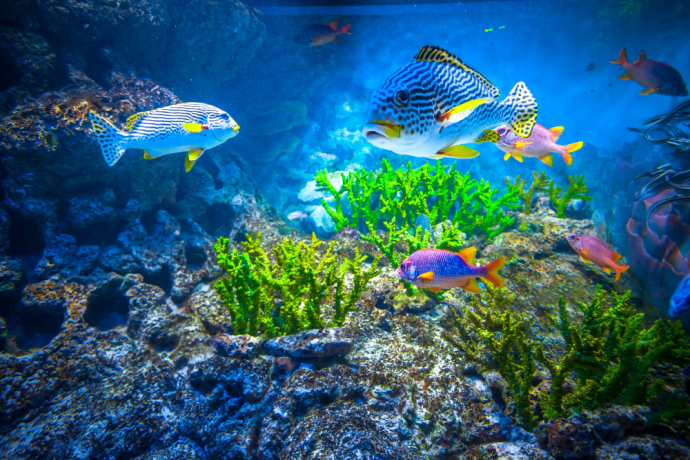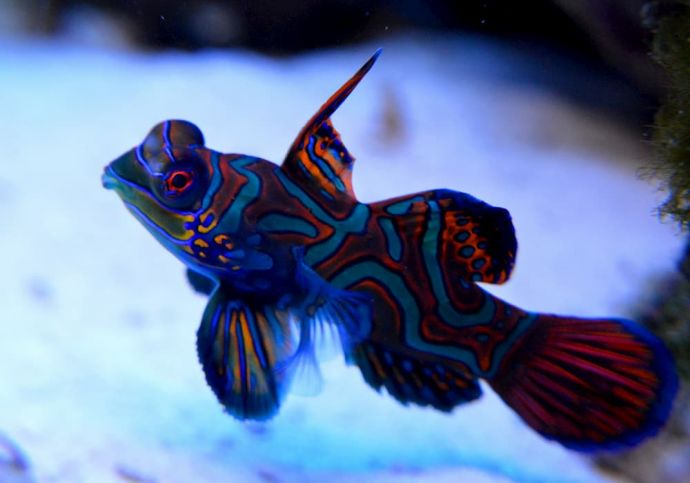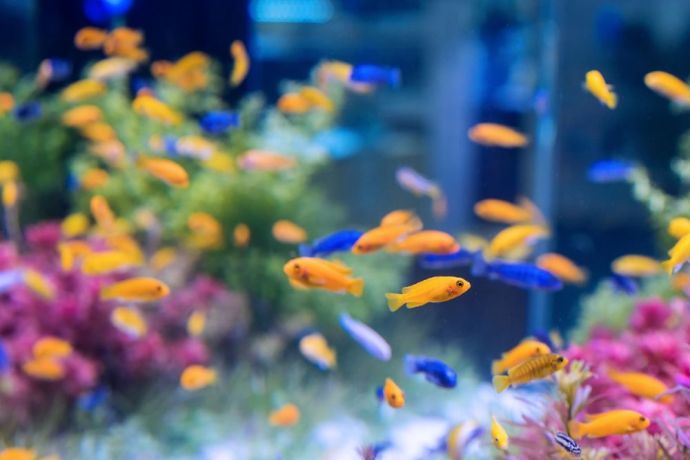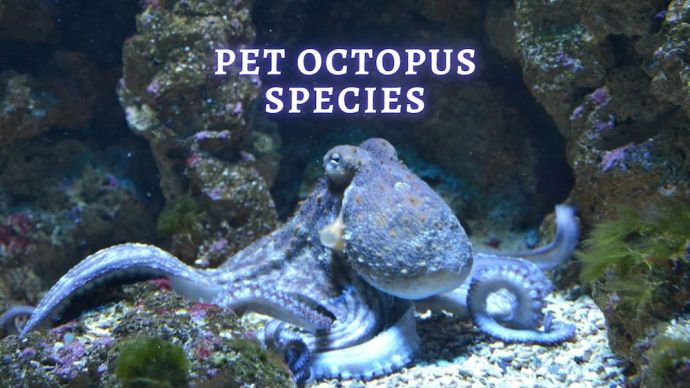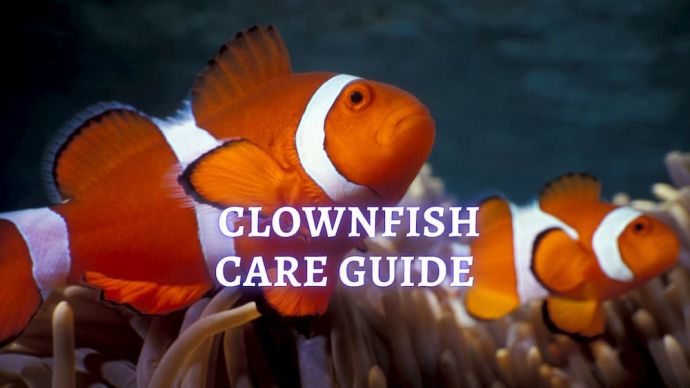Saltwater Refugiums: How to Make a Refugium for Saltwater Aquarium?
Written by:
Author: Alina Andreeva
Alina A. is a professional writer, editor, and pet-lover. She has published over 50 articles on how to care for pets properly. Alina has been writing articles for 3 years, so she has considerable experience in this niche. Her natural curiosity helps her to expand her knowledge and learn new pet care life hacks, which will make your life much easier.
View all 79 articlesLearn about our editorial process and veterinary review board.
Viewed: 735
Updated on: 07/21/2021
One of the biggest problems in keeping fish is choosing what to include in your tank. There are so many boxes to tick and questions to answer. Can the fish live in saltwater, or does it prefer freshwater? Can you purchase more than one of the same fish, or do they act aggressively towards their own species? Is your tank big enough for them? How many fish can you fit in your container? Planning your aquarium is a delicate business, as you want to achieve a certain equilibrium in which every fish is happy and healthy. Unfortunately, some more aggressive fish are known to attack the more delicate within the tank. Upstep the refugium.
What is a Refugium for Saltwater Tanks?
Refugium is a ‘refuge” that provides a separate tank for the more docile and at-risk species, keeping them safe from aggressive predators. Delicate species, such as corals and anemones, should not be held within the same tank as those who attack them.
What does a Refugium do?
Refugium allows you to connect your main tank and smaller refuge tank within the same display while keeping certain species isolated from others. These tanks can be held side by side, with the same water filtration systems. In truth, only as an extra layer of class prevents them from being the same tank.
A refugium is made to be seen, not hidden away like a reverse photosynthesis device. It is merely a quiet and safe place for copepods, seahorses, shrimpers, and more to swim, free of danger.
What to put in my Saltwater Refugium?
1. Sand Bed and Rock
However, a refugium is about more than the fish and creatures you put into it. This is also a chance to create an aesthetically-pleasing sub-section to your display tank, as primary filtration is not an issue with a refugium. Many people like to add a sand bed, around one or two inches deep, to their refugium. You can also add a few pieces of rock to this sand bed. This sand bed will make the tank look nice, but it will also provide a home for beneficial worms and other sifters. Creatures like crabs are also used to having such a base to walk around on.
2. Refugium Plants & Algae
You can also feel free to add plants and decorations, as long as they suit the species you are adding to the refugium.
Macro algae is a very important addition to your refugium. Due to their rapid growth, they help get rid of nitrates and phosphates.
In addition, macro algae are also a valuable food for fish and invertebrates.
To maintain the normal condition of the refugium, and for CO2, nutrients, and lighting of the proper spectrum, it is necessary to provide a constant flow of water. Macro algae form the hardy functional basis of any refugium.
3. Mangrove
Mangroves are unique shrubs or tall trees that grow in the coastal zone of tropical seas and oceans and in river deltas, sometimes creating impenetrable thickets. Their intertwined roots protrude above the water, forming amazing impenetrable thickets. Underwater, such formations are an ideal shelter for fry and young fish with a rich food base.
Marrowy snags do not spoil the water. To be more precise, they release a certain amount of tannin that slightly acidifies the environment. But such a dose is completely safe for aquarium inhabitants and, for some types of fish, they are even useful.
Advantageously, a well-soaked part of the mangrove root becomes heavier than water and does not float.
If the aquarium contains sucker catfish, the mangrove snag will serve as a source of cellulose, which helps them digest food. Over time, catfish will polish this wood to a completely smooth state.
Finally, snags will last for many years if not taken out of the aquarium for a long period of time. They do not rot or decompose.
4. Refugium Animals
In terms of species, you should put any fish that would not survive and thrive within your standard tank into the refugium. If there is space for them, and none of the species in the refugium are aggressive towards each other, it is doing its job.
If you are looking for examples of particular species, then small crustaceans will perfectly complement your refugium. Crustaceans, shrimp, and other small animals are some of the most popular food sources for marine fish. In a normal aquarium, and because of the constant danger, such small creatures are very difficult to breed; however, in the refugium, conditions are more favorable. Hermit crabs are also great for a refugium, as they feed on harmful algae. [1]
The refugium is one of the few places where Asterina starfish can live without causing serious problems. Starfish is a great help in cleaning seawater. Thanks to their sense of smell and thin tentacles, they find food remnants in the deepest crevices. However, keep in mind that starfish are predators and eat worms and small crustaceans that call the refugium their home.
READ MORE: Getting Rid of Brown Algae
How to make a Refugium?
The most challenging part of establishing a refugium is the actual creation.
Refugium Size
We recommend using a second smaller tank, although a cheaper way to achieve a similar result is to section off a portion of your existing tub.
Live Rock & Sand or Mud
Take your sand or mud and fill the refugium up to around one or two inches. Make a judgment call based on how big/tall the refugium is. You can then add your rocks or any other media of your choice. Remember to rinse them out and clean them before adding them. You can then add some macro algae, although ensure that it is fixed to the bottom of the tank with string, a rock, or a rubber band.
Fish
First, ensure that you turn any pump off. Otherwise, you risk it clogging the pump/filter. At this point, you can pour your chosen species into the tank and allow them to explore their new home. You should give the various creatures some food reasonably early on to get them used to be fed within new surroundings.
Lighting
Make sure that you now let the refugium settle before turning the pump back on. This ensures that all the small bacteria, crustaceans, and co can bed themselves into the sand, preventing them from being sucked away. You should then add a light above your refugium tank, as you would a typical aquarium. Make sure to harvest the macro algae every two to four weeks to prevent overgrowth.
READ MORE: The Best LED Light for a Reef Tank
Why use Refugiums?
- First, the refugium is intended for the safety of fish that are most vulnerable to extinction. A refugium can help such creatures acclimatize in a calmer environment (away from the inhabitants of the main aquarium). In addition, such an aquarium contributes to the quiet development and preservation of the offspring of fish and other inhabitants. The refugium helps them develop in a safe environment while maintaining their habituation to the water/conditions of the main aquarium.
- Some people also use refugium to grow algae. This helps to absorb waste that would otherwise contaminate the main aquarium.
- A refugium is very effective if you want to grow “feed” organisms to a certain size so that they can reproduce before being eaten by other fish.
- A refugium can also serve as a sump, which plays an important role in the flow of water in reef aquariums.
- A refugium is often used for the safe increase of water in the aquarium. For example, a 60-gallon aquarium with a 10-gallon refugium is actually a 70-gallon system; the extra volume makes the water in the tankless susceptible to temperature fluctuations and other interference.
READ MORE: How to Clean a Freshwater Tank
Types of Refugiums
Refugiums can be divided into three types: sump based, in-tank and hang-on. Each type is created for specific purposes:
Sump
This type of refugium is the second aquarium, which is located below the main aquarium. This can provide additional filtration of reef aquariums. The cost of such a refugium, which includes a sump and protein skimmer, can range from $350 to $600. You may also need additional expenses if you are planning to purchase a ready-to-use aquarium with all the parts and plumbing ready for use.
Pros
Cons
- Ideal for growing algae that helps break down or absorb waste. It is also used to filter water from the main aquarium.
- It is necessary to regularly monitor the inhabitants.
In-tank
An in-tank refugium is the simplest type of refugium. Basically, you put a small container in the aquarium that keeps the small inhabitants inside and the big fish outside. The price range of this type is from $35 to 50 dollars, depending on the size of the refugium.
Pros
Cons
- Such a refugium does not take up much space.
- You can’t run separate lighting schedules for the main aquarium and the refugium.
Hang-on
The hang-on refugium is a separate container that is attached to the back of the aquarium. For this type, you need to buy an additional pump for pumping water to and from the refugium. The price range for this model is from $75 to $150, depending on the size of the refugium.
Pros
Cons
- The hang-on refugium divides the water between the main aquarium and the refugium and can serve as a sump.
- You will need some space behind your aquarium, so it can’t be large. It is also a more expensive option than in-tank refugium.
Water Quality Buffer
The water in a small aquarium can’t regenerate itself, as it would in nature; therefore, without help, your fish will be under the influence of an unhealthy environment. Tap water, your residents’ metabolic waste and blooming algae all contribute to water pollution. Organic compounds are compounds that contain carbon and hydrogen and may also contain other atoms. Often, these compounds contain nitrogen or phosphorus. If the concentration of organic substances in the aquarium is too high, your aquarium inhabitants may be severely affected.
When a refugium is added, the volume of the secondary sump increases the total volume of the aquarium ecosystem, allowing you to keep more fish and invertebrates, as a larger volume of water provides more biological filtration.
Another advantage of the refugium is additional pH stabilization. If macro algae already live in your main aquarium, you probably know that they release oxygen during the day. On the other hand, at night, plants and algae use oxygen and emit CO2. Too much CO2 can cause problematic shifts in pH.
Thanks to the use of a refugium, you can mitigate the fluctuations of O2-CO2 by alternating the day and night light cycle.
When the main aquarium is in daytime mode, the refugium should be dark, and vice versa, to maintain constant levels of carbon dioxide and pH.
Refugium Lighting
For proper growth of plants and algae in the aquarium, it is necessary to ensure the correct spectrum of light in the tank. It is best to choose spectra that are ideal for green macro algae species, as they grow faster than most red macro algae species.
You can purchase, in any pet store, LED strips with a spectrum adapted to the ideal growth of algae! One example is ChaetoMax LED strips from Innovative Marine.
Protein Skimmers vs. Refugiums
Protein skimmers are another popular choice for organic waste management. Protein skimming is a water purification method used in many marine aquariums. The skimmer removes dissolved and dispersed organic substances from the aquarium water and provides increased aeration.
The dirt removed by the skimmer is physically removed from the water. In traditional mechanical filters, uneaten food, waste, etc. are retained in the filter material, but are still in contact with water. In the flotator, organic compounds are placed in a special container from which they can be removed later.
Standard mechanical filters remove particles about a millimeter in size. From this, we can conclude that the skimmer filters at a much lower level.
Main advantages of protein skimmers:
- Remove organic compounds and waste from your aquarium water
- Saturation of water with oxygen, due to many bubbles in the tube
- Mechanical filtration can be more convenient and easier to manage compared to a secondary ecosystem
Main advantages of refugiums:
- Provides complete detoxification of nitrates (with the right substrate)
- Can significantly increase the total volume of the aquarium
- Provides space for the growth of detritus and macro algae
Refugium Diagram
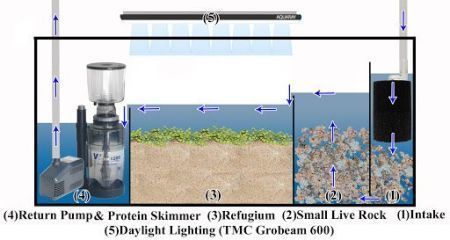
americanaquariumproducts.com
Article Sources:
- Barrington, Kate. “The Cost Of Owning A Hermit Crab – We’re All About Pets.” We’re All About Pets, 7 Oct. 2020, wereallaboutpets.com/hermit-crab-cost









